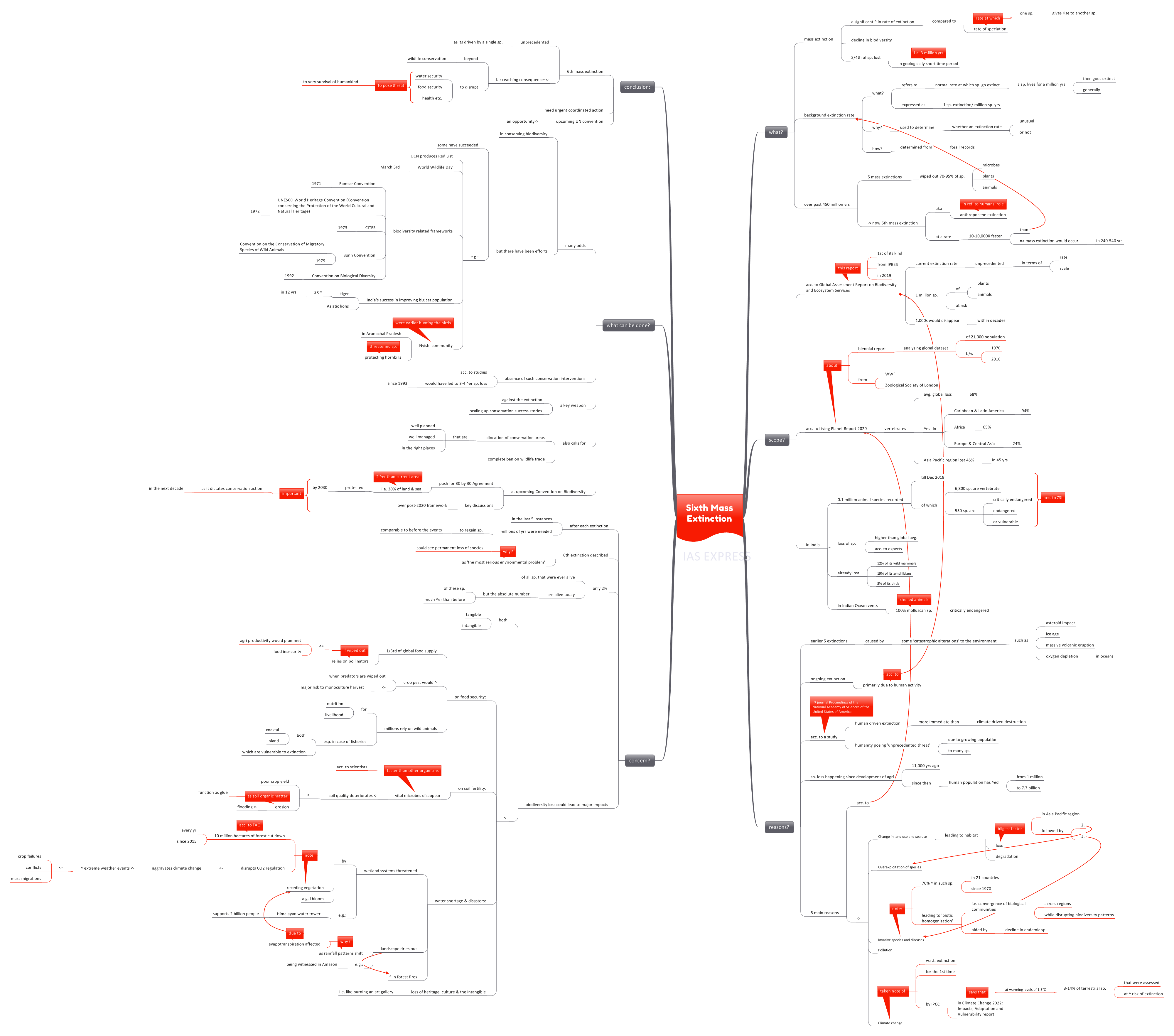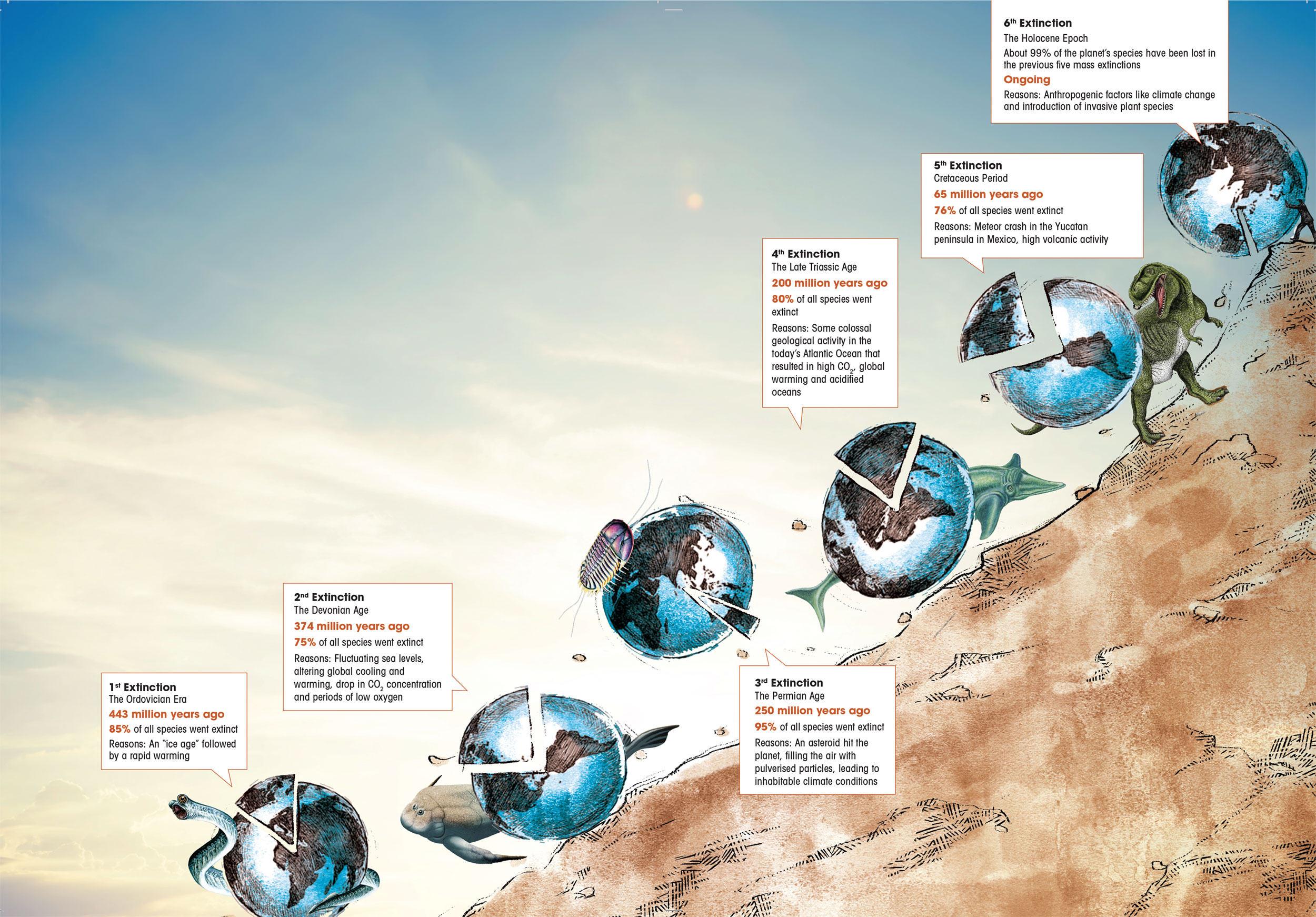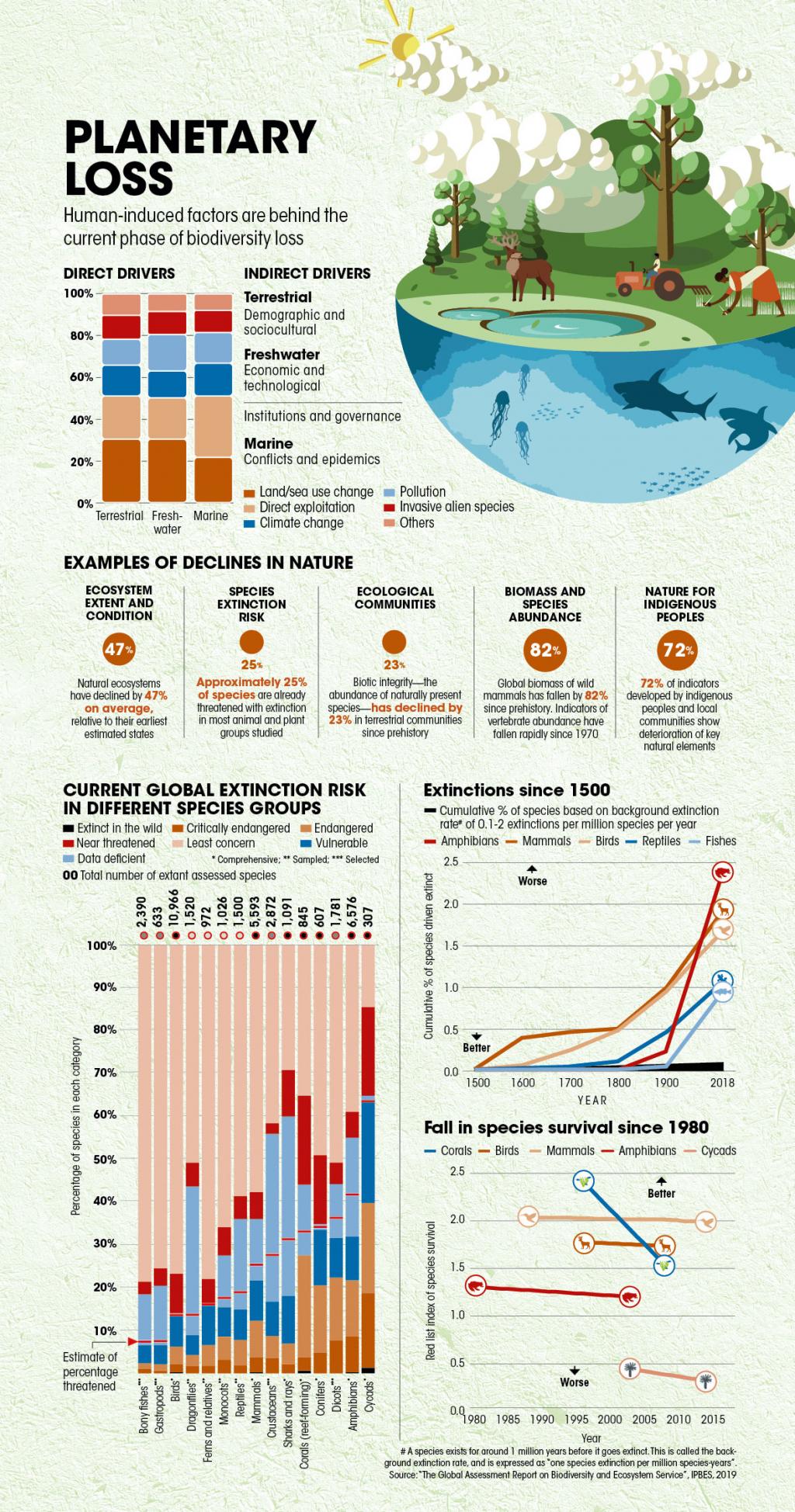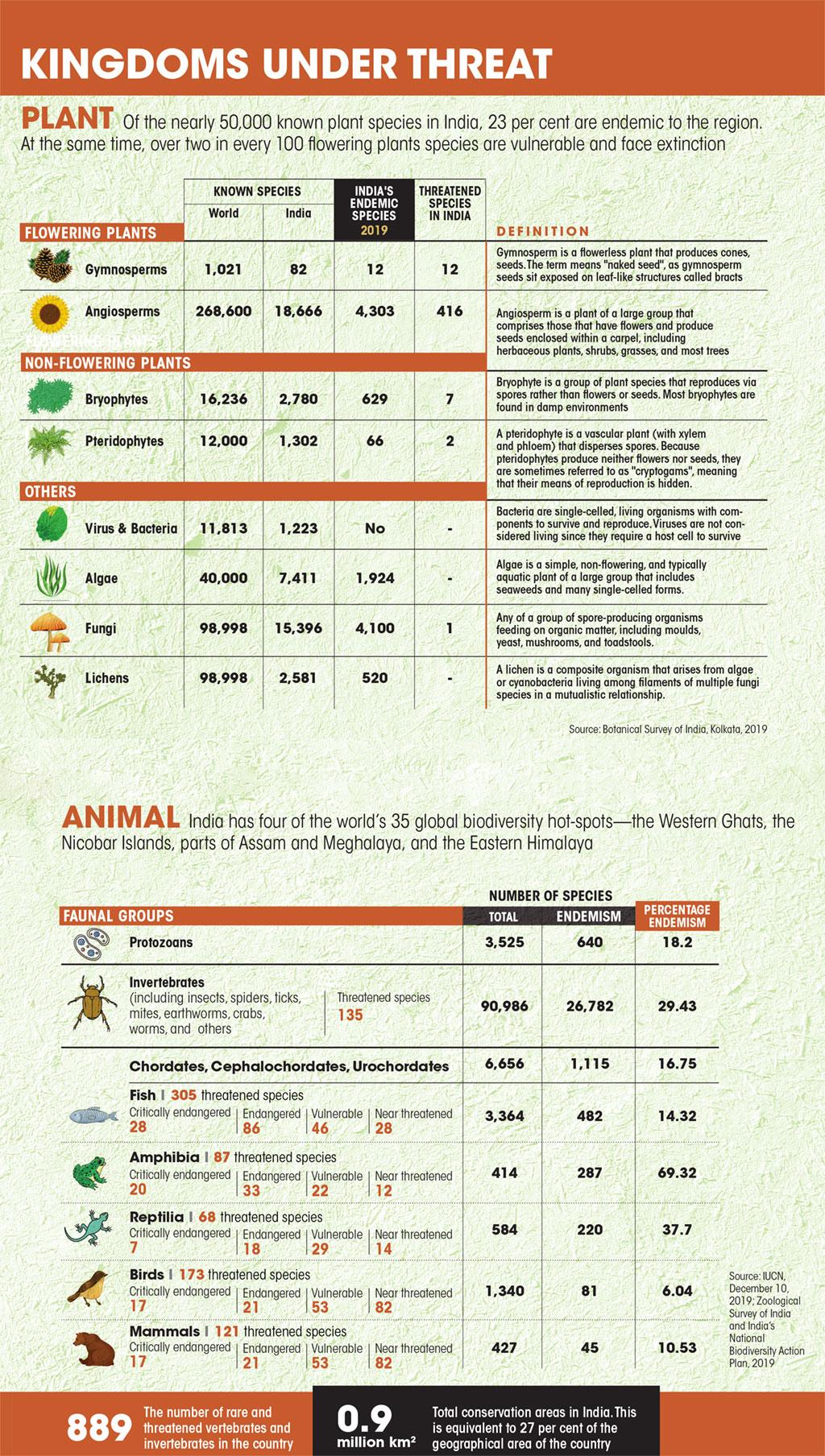Sixth Mass Extinction

The UN Biodiversity Conference (COP 15) is set to be convened in October, 2022. It comes at a key period in conservation history- following an unprecedented pandemic, increasingly alarming reports on the environment and, also at a time characterized by higher awareness and concern over the declining biodiversity. The ongoing mass extinction is especially significant for it is driven by a single species- Homo sapiens.
This topic of “Sixth Mass Extinction” is important from the perspective of the UPSC IAS Examination, which falls under General Studies Portion.
What is the Sixth Mass Extinction?
- Mass extinction is a significant increase in the rate of extinction, compared to the rate of speciation– i.e. a decline in biodiversity. It is when the planet loses over 3/4th of the total species in a geologically short time period.
- According to fossil records, a species exists for about a million years before going extinct. This is referred to as ‘background extinction rate’, expressed as 1 species extinction per million species-years. This is used to determine whether an extinction rate is unusual or not.
- Generally, mass extinction involves the loss of 3/4th of the species within a period of 3 million years.
- Over the past 450 million years, there have been 5 mass extinctions. These have wiped out some 70-95% of the living species- microbes, plants and animals.
- Currently, we are witnessing what scientists are referring to as the Anthropocene extinction– the 6th mass extinction.
- According to estimates, the current extinction rate is 10 to 10,000 times more than the background rate. At this rate, mass extinction would be reached in 240-540 years.
Scope:
- ‘Global Assessment Report on Biodiversity and Ecosystem Services’ report:
- It is the first of its kind report released by IPBES (Intergovernmental Science-Policy Platform on Biodiversity and Ecosystem Services) in 2019.
- It stated that the current extinctions’ rate and scale is unprecedented.
- 1 million species– plants and animals- are at the risk of going extinct. Thousands of these would disappear within decades.
- Living Planet Report 2020:
- This biennial report was published by WWF (World Wildlife Fund) and Zoological Society of London. It is an analysis of the global dataset, tracking 21,000 populations of animals, between 1970 and 2016.
- According to this report, the average global loss of vertebrate species is 68%.
- Loss of vertebrate population was highest in:
-
-
- Caribbean and Latin America (94%)
- Africa (65%)
- Europe and Central Asia (24%)
-
-
- The Asia Pacific region has lost 45% of its vertebrates in just 45 years.
- In India:
- Experts opine that the loss of species could be higher than global average in India.
- India has already lost (in the last 50 years):
-
-
- 12% of its wild mammals
- 19% of its amphibians
- 3% of its birds
-
-
- In India, some 0.1 million animal species were recorded till December 2019. Of these, 6,800 are vertebrate species. About 550 of these species are now either critically endangered, endangered or vulnerable, according to ZSI (Zoological Survey of India).
- In the Indian Ocean vents, 100% of molluscan species are listed as critically endangered.
What is driving this extinction?
- The earlier 5 extinctions were caused by some ‘catastrophic alterations’ to the environment, such as- impact of an asteroid, ice age, massive volcanic eruption or depletion of oxygen in the oceans.
- According to the IPBES report, the ongoing extinction is primarily driven by human activity.
- A study, published in the journal Proceedings of the National Academy of Sciences of the United States of America, claims that human-driven extinction is more immediate than climate destruction. Humanity is posing an ‘unprecedented threat’ to many species because of the growing population.
- The loss of species has been going on since the development of agriculture some 11,000 years ago. Since then, the human population has swollen from 1 million to 7.7 billion.
- According to the Living Planet Report 2020, there are 5 main reasons behind this loss of biodiversity across the world:
-
- Change in land use and sea use- leading to habitat loss and degradation
- Overexploitation of species
- Invasive species and diseases
- Pollution
- Climate change
- In the Asia Pacific region, habitat degradation is the biggest factor followed by species overexploitation and invasive species and diseases.
- Since 1970, the number of invasive alien species has increased by 70% in 21 countries. This is driving ‘biotic homogenisation’ i.e. convergence of biological communities across the regions, disrupting biodiversity patterns. This is further aided by decline in endemic species.
- The IPCC, in its report ‘Climate Change 2022: Impacts, Adaptation and Vulnerability’ has taken note of the climate change’s role in species extinction, for the first time. According to the report, at global warming levels of 1.5°C, 3 to 14% of the assessed terrestrial species are at high risk of extinction.
Why is it a concern?
- It is notable that after each of the previous 5 extinctions, it took millions of years to regain species comparable to those that lived before the event.
- Researchers have described the 6th Mass Extinction as ‘the most serious environmental problem’. This is because the loss of species could be permanent.
- Currently, only 2% of all the species that ever lived are alive today. However, the absolute number of species now is much higher than ever before.
- The loss in biodiversity could have tangible and intangible impacts:
On Food Security:
- Some 1/3rd of global food supply relies on pollinator species (e.g.: bees). If these species disappear, agricultural productivity would plummet and lead to food insecurity.
- At the same time, as predator species are wiped off, some crop pests would start thriving. This is a major risk for monoculture harvests.
- Millions of people rely on wild animal species for nutrition and livelihood. This is particularly true in case of coastal and inland fisheries, which are vulnerable to extinction.
On Soil Fertility:
- When vital microbes are wiped out, soil quality would deteriorate and some scientists believe that these organisms are disappearing at a faster rate than other organisms.
- This has potential to worsen, not only crop yield, but also erosion and flooding. This is because the organic content in the soil functions as a glue, in addition to providing nutrients to the crops.
Water Shortage & Disasters:
- Receding vegetation and algal blooms pose a threat to wetland systems. These wetlands are vital for the fresh water sources that sustain life. Eg: the Himalayan water tower supports some 2 billion people.
- Landscape could dry out as the rainfall patterns shift erratically. This is because evapotranspiration gets affected when forests recede. This situation is being witnessed in the Amazon region.
- Forest fires are now occurring with increasing frequency.
- With 10 million hectares of forests being cut down every year since 2015 (according to FAO), the regulation of atmospheric carbon dioxide is disrupted, aggravating climate change and triggering more extreme weather events.
- This could in turn trigger crop failure, conflicts and mass migration of people.
Loss of Heritage, Culture & the Intangible:
- Some have compared the mass extinction to the burning of an art gallery i.e. the intangible loss of heritage rather than the potential direct value. It takes millions of years of evolution for a species to come into existence. Now these are being wiped out in decades.
What can be done?
- While there are many odds facing the conservation of biodiversity, there have been efforts and some have even succeeded in turning the tide.
- The IUCN produces the Red List– the fundamental basis of insight into this entire extinction event.
- World Wildlife Day observed on March 3rd to raise awareness
- India’s tiger population has doubled over the last 12 years. This has been aided by government initiatives and NGOs. Tourism has contributed positively and some former poachers are now conservationists.
- India has seen success with its Asiatic Lion population too.
- The Nyishi community, who were earlier hunting the hornbills in Arunachal Pradesh, are now active protectors of these threatened bird.
- Studies show that, in the absence of such conservation interventions, the species loss since 1993 would have been 3-4 times worse.
- A key weapon against the 6th Mass Extinction is scaling up conservation success stories.
- There are several biodiversity-related international frameworks:
-
- Ramsar Convention of 1971
- UNESCO World Heritage Convention (Convention concerning the Protection of the World Cultural and Natural Heritage) 1972
- CITES 1973
- Bonn Convention or Convention on the Conservation of Migratory Species of Wild Animals, 1979
- Convention on Biological Diversity, 1992
- Conservationists are calling for allocation of well-planned and well-managed conservation areas– in the right places.
- Some conservationists have been calling for a complete ban on wildlife trade, especially post the outbreak of the COVID-19 pandemic. Wildlife trade- both legal and illegal- are decimating many of the endangered species.
- There have been efforts to push the ‘30 by 30’ Agreement at the upcoming Convention on Biodiversity. Under this agreement, 30% of lands and seas would be under protection by 2030. This is double the area that is currently under such protection.
- The convention will also see the discussion on post-2020 framework for biodiversity conservation. This framework is key to conservation action over the next decade.
Conclusion:
The 6th Mass Extinction is unprecedented in that it is being driven by a single species. This biological annihilation can have far reaching consequences- that go beyond wildlife conservation to disrupt water security, food security, health, etc. and pose a threat to the very survival of humankind. Urgent coordinated action is imperative and informed initiative at the upcoming UN Convention could serve as a starting step.
Practice Question for Mains
Experts opine that the Sixth Mass Extinction is underway. How big of a role is human activity playing in this respect? What can be done to address it? (250 words)





